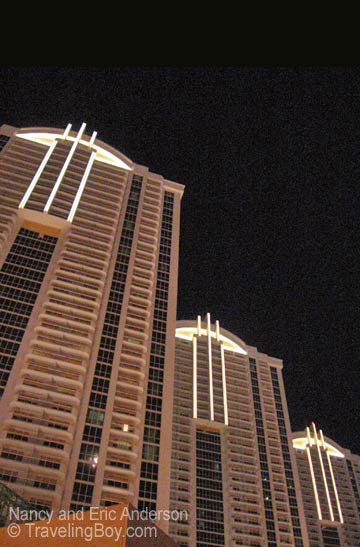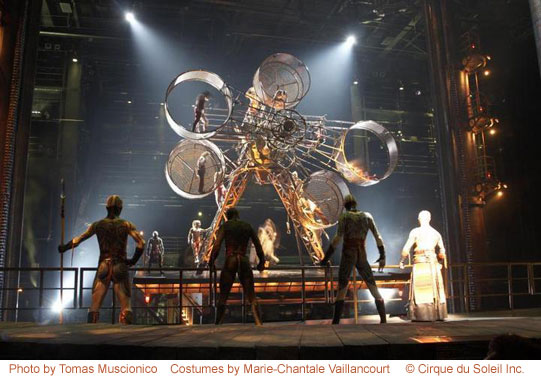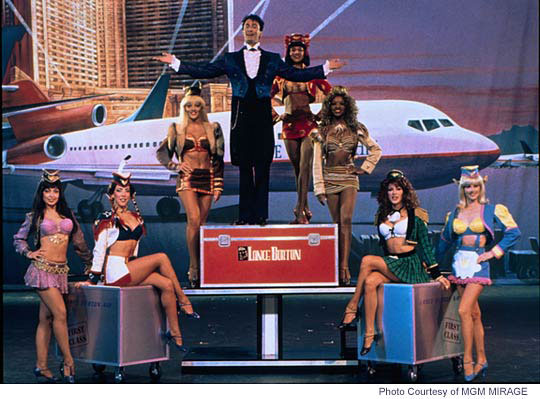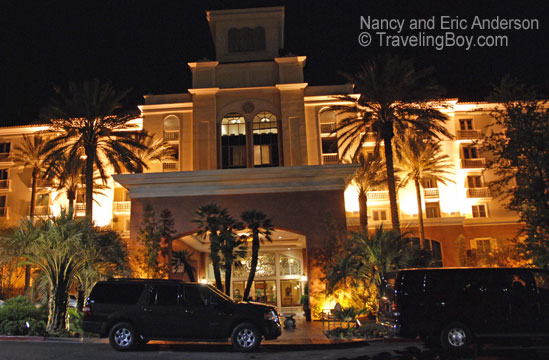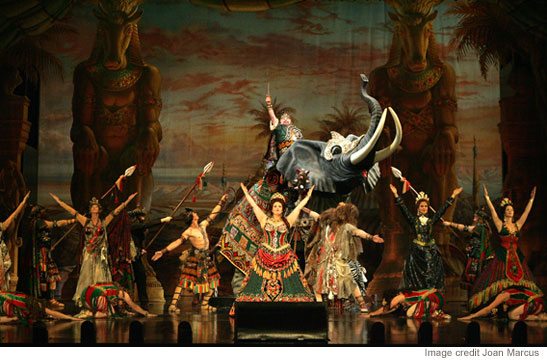 |
 |
|
 |

|
Las
Vegas:
Still the Only Game in Town Story and photography by
Nancy & Eric Anderson
The three towers run efficiently like a Swiss watch
- no surprise since Luvisotto trained in the School of Hotel Management
in Switzerland. Valet parking is free (as it is almost everywhere in
town), the suites all have high-end kitchenettes, flat screen HDTVs,
WiFi in rooms and even iHome clock radios for iPods. Room service is
24/7 and the resort offers same-day laundry and dry cleaning. Although
guests can use all the facilities of the MGM Grand including its pools,
Tower 1 has a Starbucks, Tower 2 has a deli and Towers 1 and 3 have
fitness centers. And if the tranquility gets to you and gives you itchy
feet it turns out access to the busy MGM Grand with its ocean-liner
feel is a real plus. Your Signature concierge apparently carries clout:
getting great tickets for KÀ, for example, is a breeze as is
a reservation for one of the MGM Grand's new restaurants such as Michael
Mina's Sea Blue with its "jet fresh" seafood. You need to
give yourself time at Sea Blue, the meal is a show in itself. Pencils
with planning menu sheets are provided so you can truly customize your
salad components or even the entire meal. Chef Stephen Hopcraft believes
what makes Sea Blue’s items special, such as the very best crab
legs we ever tasted, is they begin with fresh, never-frozen fish specially
jetted from Alaska, start their grill with mesquite charcoal then use
an apricot wood-burning grill that they lower as the wood burns down.
His skills are infectious. Says assistant general manager, Luke Mathot,
“Since working here, I’ve learned about sauces, found how
to shuck oysters and where to buy the best produce in town.”
KÀ
is described as "the epic tale of twins on a perilous journey to
fulfill their shared destiny." It's helpful to know that because
this further example -- that demonstrates how Cirque du Soleil is beginning
to dominate Las Vegas -- is the first company product to try and tell
a story. And how does it do that? First separating the twins by political
enemies then sending each on a voyage of discovery, fraught with danger,
using barges, acrobats, soldiers and experts in martial arts throwing
spears and shooting arrows. We see kick boxing, a shipwreck with beautiful
representations of drowning and salvation. We see sea monsters crawling
in the sand then the stage turns upright and the sand cascades off like
a waterfall. The stage becomes a cliff, rescuers help those shipwrecked
ascend to safety and to their primitive home atop the precipice. The
home becomes a flying bird that pirouettes in space and flies to refuge. It's all hard to follow and any description will, of
necessity, be incoherent. Watching KÀ with its diverse points
of visual interest is like trying to find that guy with the red-striped
shirt in the game, "Where's Waldo?" It is dazzling. It is
about costumes and music, the confrontation of good and evil, the triumph
of love, the symbolism of faith, the rewarding of good deeds. In ancient
Egypt KÀ was though to be a component of the human soul, one
of the five parts that merged to form a person. Here it is taken to
be the spiritual duplicate that accompanies a person through life. This
concept produces a colorful, exciting, fast-moving spectacle that suggests
a far away place with exotic strange people in a performance that lingers
long after the curtain comes down. If money is tight, you can afford high-priced shows
if you can find inexpensive places to put your head down at night. Silverton
Casino Lodge is where many Nevadans stay when they come to town
because the price is right. With 300 large rooms it sits 3 miles south
of Mandalay Bay on the west side of Interstate 15 as you come into town.
Its current $130 million expansion program will increase its gaming
space from 60,000 sq ft to 95,000 and its slots from1400 to 2200. It
will add three restaurants to its current four and build a separate
$15 million concert hall that will seat 2000 patrons. Meantime it's
called the "Best Local Casino" by the 2007 City's Bestâ
Award and more recently the "Best Budget Hotel" and the "Best
Free Attraction" in the Best of Citysearchâ 2008 awards (for
the magnificent 117,000 gallon saltwater aquarium in its lobby. The
aquarium holds more than 4000 tropical fish including four species of
stingray and six species of shark - and while we were taking photographs,
one mermaid). Silverton also has what the PR representative for Monorail
said was the best steakhouse in Las Vegas, the Twin Creeks Restaurant.
She got that right but Twin Creeks is much more than a simple steakhouse.
It has undergone a $4 million renovation, the first location in the
lodge to be upgraded and is now an elegant, peaceful place with wonderful
wines, exciting menus and boutique bourbons,. It has for example, 21
bourbons priced from $6 to $58 a shot (for a 23 year-old Pappy Van Winkle)
and 14 single malt Scotches for $8 to $33 (for an 18 year-old Macallan). Lance
Burton (Monte Carlo) Magicians live and work in a virtual secret society.
They honor their own. Alexander Hermann, for example, came from a family
with a 100 year history of magicians. When he died in 1896, Harry Kellar
became the acclaimed leader in America. When he retired in 1908 he declared
Howard Thurston his successor. Before Thurston died in 1936 he appointed
"the Great Dante" his successor. Dante retired in the late
1940s selecting Lee Gabel as his successor. Gabel retired in 1959 and
in 1994 chose Lance Burton to succeed him as America's premier magician.
And so we move into the present. The Monte Carlo, at a cost of $30 million, built Burton a special theater in 1997 and he has been performing there ever since. "Lance is a classical magician and a classy act," says his publicist, Wayne Bernath. "He does it all. He's laid back and loves his audience. Some analytical people may think they know how his tricks are done, but they're going to be wrong. Besides, if you were ever able to puzzle out how a trick works it would be like finding out there's no Santa Claus." It's not likely we're going to puzzle out Lance Burton's
secrets - or want to. On stage, he has a very easy style. "Welcome
to Las Vegas," he says, "That's an Indian word for 'empty
pockets.'" He notices a guest eating popcorn. "Why not,"
he tells his audience, "This is a dinner show." He produces
doves from candles - a trick he has started his show with for years,
then produces six beautiful assistants from his suitcase. "You
should always travel with a six-pack," he says. He turns napkins
into budgiegars, and transfers bars of gold from a safe into a gold
costume for his assistant. He appears as a native American shaman and
makes his tepee disappear, he produces a Corvette from the blue then
has it vanish. Ducks and geese appear from nowhere in the middle of
a masked ball. Children in the audience are suspended in space or evaporate. For us the funniest part of his show was "The Magic
Zone," a one-act play with murder and mayhem that unfolded like
a French Farce or a scene from the "Twilight Zone." He uses
virtually all his cast including his marvelous funny juggler, Michael
Boudeau, in a six-minute romp where people appear and disappear faster
than you can keep track of. JW
Marriott Las Vegas Resort, Spa & Golf What's to like? For starters 24-hour room service and
WiFi internet access but we expect that in most luxury hotels these
day. A casino in the rear if you want it. More than eight restaurants
including the upscale Ceres where you can enjoy Mediterranean fare while
gazing out at waterfalls and keeping a protective eye on the resort's
mother duck and her five little ones wandering outside -- proud of their
decision, like yours, to stay off the Strip. Guests, but not the ducks,
can utilize the complimentary shuttle to the Las Vegas Strip, and benefit
from the free shoeshine and daily newspaper. And they can enjoy 54 acres of gardens with more than
3500 trees. A grass-edged 11,000 sq ft swimming pool with a cascading
waterfall and four 75 ft swimming lanes (an Olympic pool is about 164
ft). A 40,000 sq ft spa and a fitness center with, in the spa, 36 treatment
rooms. The resort is particularly proud of its "Aqua Sulis"
spa and when you try its fare you'll see why. Preferred tee times are
granted guests at the celebrated TPC
(The Players Championship) course next door -- and more than a half
dozen local courses are nearby.
What was not missing were the spectacular stage settings
and the sumptuous sense of a Victorian opera hall with velvet curtains
and organ music, box seats used for props and performers, and the subtlety
of the stage direction that had actors positioned as if in a tapestry
or painting. This was not only music for the ears but a visual feast;
in one scene, as Christine sang, the chorus was being instructed in
dance by the ballet mistress. The scene was reminiscent of paintings
by Degas. The costumes for the masked ball, the great visibility from
just about all seats and the awe-inspiring acoustics absolutely delighted
the senses and made this visit to the theater (specially created by
the Venetian) an enchanting event. The actors seemed truly to be living
their roles, throwing their hearts into their performance. Much has
been written about the creation of the complicated and high tech Opera
House chandelier for the Las Vegas show but in our opinion its descent
here had nothing like the impact of the contrived collapse of the chandelier
at Her Majesty's Theatre in London. |
In the meantime, here are some of the feedback we have already received: * * * * *
|
![]()
Stay tuned.
This site is designed and maintained by WYNK Marketing. Send all technical issues to: support@wynkmarketing.com

|











